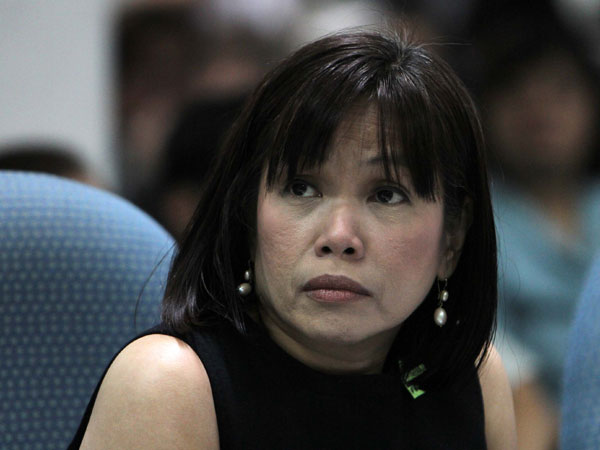
National Treasurer Rosalia de Leon. (INQUIRER FILE PHOTO)
MANILA, Philippines–The Philippines’ gross borrowings will peak to a record-high P1.4 trillion next year to finance the government’s programmed wider budget-deficit cap equivalent to 3.2 percent of gross domestic product (GDP) as it jacks up spending on public goods and services while also paying more amortization for outstanding debt.
During the Development Budget Coordination Committee (DBCC) meeting, the interagency body kept the borrowing program for 2019 at P1.18 trillion, of which the bulk or 73 percent will be sourced locally mainly from the sale of treasury bills and bonds amid ample domestic liquidity, National Treasurer Rosalia V. de Leon said.
The bias for domestic borrowings would minimize foreign exchange risks, economic managers had explained.
Foreign borrowings, meanwhile, will come from offshore bond issuances and official development assistance (ODA) loans from bilateral partners and multilateral lenders.
As the DBCC also approved a wider budget-deficit ceiling equivalent to 3.2 percent of GDP for the rest of the Duterte administration’s remaining years in office until 2022, de Leon said total gross borrowings next year will jump to P1.4 trillion, with a borrowing mix of 75-percent domestic, 25-percent external.
Even as the country’s borrowings further increased, the debt-to-gross domestic product (GDP) ratio will be steady at 41.4 percent this year and next year, de Leon said.
In 2018, the debt-to-GDP ratio stood at 41.9 percent, and the government wanted to bring the share of debt to the economy to 38.6 percent in 2022 by sustaining strong economic growth.
Economic managers had said that while the government’s nominal debt continued to rise—the outstanding amount hit a new high of P7.916 trillion in May, the debt-to-GDP ratio was a better measure as a figure below 60 percent meant the economy remained in good shape and can pay its obligations.
De Leon later told reporters that the record-high borrowing program for next year will only be a “blip” as it would go down to about P1.2-1.3 trillion after 2020.
“There’s just a slight spike [in 2020]. In 2018, given the high [interest] rates, we have not really been accepting [bids] in the [Bureau of the Treasury’s] auctions… The amortization [payments] for 2020 is quite big because before we were doing [debt] exchanges, so given high rates we’re not able to do some of the exchanges. So if we do some now that rates are coming down, then we will be able to manage more,” de Leon explained during an ambush interview.
Previously, the budget-deficit program for 2020-2022 was a lower 3 percent of GDP, but Finance Assistant Secretary Maria Teresa S. Habitan explained that they had to adjust the cap given adjustments in revenue targets and lower estimates of nominal GDP in the coming years.
“There’s also some pressures for the infrastructure programs to come on-stream by 2022 so we needed enough room to expand and hence the decision of the DBCC to increase the [budget-deficit] ratio to GDP,” Habitan added.
“We would want to hit our targets in terms of infrastructure spending as a percentage of GDP so it could really bolster in terms of multiplier effect to our growth,” de Leon, for her part, said.
For 2020, the DBCC programmed a nominal budget deficit of P677.6 billion.
As for 2019, the DBCC earlier already jacked up the budget-deficit ceiling to 3.2 percent of GDP, and Department of Budget and Management (DBM) Officer-in-Charge (OIC) Janet B. Abuel was optimistic that the government can achieve this goal through its spending catch-up plan.
“For DPWH [the Department of Public Works and Highways], it is on track; for DOTr [the Department of Transportation], it needs catching up because of some requirements, especially the bigger projects like rails would require so much studies and paperworks. But they also have pending requests that were not captured because the evaluation that we did or the reports were as of June 30, so we are expecting them to have bigger or increase requests for funding by July onwards,” Abuel said.
By yearend, the government had been programmed to post a P624.4-billion budget deficit as the P3.77-trillion expenditure program should outpace the targeted collections of P3.15 trillion in tax and non-tax revenues.
But the latest Treasury data showed that as of May, the five-month budget deficit narrowed by 99.4 percent to only P809 million from P138.7 billion during the same period last year.
The Treasury had mostly blamed the smaller end-May deficit to the delayed approval of the 2019 national budget.
To recall, President Duterte signed this year’s P3.7-trillion budget only in mid-April as the two houses of Congress squabbled over “pork” funds, such that the government operated using reenacted 2018 appropriations during the first four months and underspent about P1 billion a day. /jpv